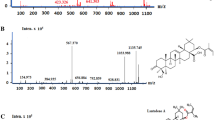The present study reports the comparative in vitro cytotoxicity of theaflavin digallate (2) and isotheaflavin digallate (1), a new black tea theaflavin against Chinese hamster ovary cells (CHOK1) and rat glioma cells (C-6). Compound 1 was formed by the immobilized polyphenol oxidase (PPO) mediated enzymatic oxidation of (–) GCG and (–) ECG along with compound 2, which was formed by enzymatic oxidation of (–) EGCG and (–) ECG. The structures of the compounds were elucidated using ESI-Q-TOF-MS and 1D and 2D NMR. The results of a comparative cytotoxicity assay have revealed that isotheaflavin digallate is more cytotoxic than theaflavin digallate (IC50 246.8 μg/mL against CHOK1, IC50 288.8 μg/mL against C-6 cells).

Similar content being viewed by others
References
A. R. Ipeaiyeda and M. Dawodu, Electron. J. Environ. Agric. Food Chem., 10, 2240 (2011).
M. Salahinejad and F. Aaki, Biol. Trace Elem. Res., 134, 109 (2010).
M. Yemane, B. S. Chandravanshi, and T. Wondimu, Food Chem., 107, 1236 (2008).
A. Kumar, A. Nair, A. V. R. Reddy, and A. N. Garg, Food Chem., 89, 441 (2005).
E. A. H. Roberts, J. Sci. Food Agric., 9, 381 (1959).
D. J. Millin, D. J. Crispin, and D. Swaine, J. Agric. Food Chem., 17, 717 (1969).
S. Scharbert, M. Jezussek, and T. Hofmann, Eur. Food Res. Techol., 218, 442 (2004).
K. L. Leung, Y. Su, R. Chen, Z. Zhang, Y. Haung, and Z. Chen, J. Nutr., 131, 2248 (2001).
Z. Yang, G. Jie, F. Dong, Y. Xu, N. Watanabe, and Y. Tu, Toxic. Vitro, 22, 1250 (2008).
D. T. Coxan, A. Holmes, and W. D. Olis, Tetrahedron Lett., 60, 5241 (1970).
J. R. Lewis, A. L. Davis, Y. C. Alan, A. P. Davis, J. P. Wilkins, and M. Pennington, Phytochemistry, 49, 2511 (1998).
S. Sang, S. Tian, R. E. Stark, C. S. Yang, and C. T. Ho, Bioorg. Med. Chem., 12, 3009 (2004).
J. Peterson, J. Dwyer, S. Bhagwat, D. Haytowitz, J. Holden, and G. J. Beecher, Food Comp. Anal., 18, 487 (2005).
I. Ikeda, Asia Pacific. J. Clin. Nutr., 17, 273 (2008).
S. M. Lee, C. W. Kim, C. K. Kim, H. J. Shin, and J. H. Biak, Lipids, 43, 419 (2008).
C. S. Buelga and A. Scalbert, J. Sci. Food Agric., 80, 1094 (2000).
H. P. Singh and K. Sharma, U.S. Patent 0298140 A1 (2009).
H. P. Singh and S. D. Ravindranath, J. Sci. Food Agric., 64, 117 (1994).
S. Sang, C. S. Yang, and C. T. Ho, Phytochem. Rev., 3, 229 (2004).
S. Patel, N. Gheewala, A. Suthar, and A. Shah, J. Pharm. Pharm. Sci., 1, 38 (2009).
Acknowledgment
We express our gratitude to the Director, CSIR-Institute of Himalayan Bioresource Technology for encouragement.
Author information
Authors and Affiliations
Corresponding author
Additional information
Published in Khimiya Prirodnykh Soedinenii, No. 5, September–October, 2015, pp. 718–721.
Rights and permissions
About this article
Cite this article
Rana, A., Kumar, D., Joshi, R. et al. Cytotoxic Activity of Black Tea Theaflavin Digallates Against Chinese Hamster Ovary Cells (CHOK1) and Rat Glioma Cells (C-6). Chem Nat Compd 51, 835–839 (2015). https://doi.org/10.1007/s10600-015-1428-z
Received:
Published:
Issue Date:
DOI: https://doi.org/10.1007/s10600-015-1428-z




